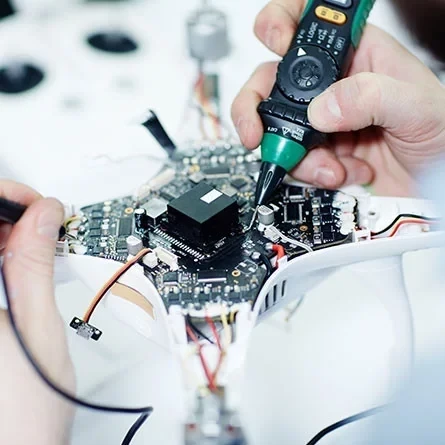Whether you are a landlord or business owner, office manager or construction supervisor, healthcare lead or head honcho at a hotel – the likelihood is you’ll be using some sort of portable appliance. And that means you’ll require portable appliance testing, known more commonly as PAT testing.
Microwaves, toasters, printers and hair dryers. And, of course, laptops. These are all appliances that should ideally have a valid PAT testing certificate if you are to meet legal requirements and/or electricity at work regulations in England and Wales.
So, whether you are dealing with a power tool on a construction site, or a microwave that plugs into a wall, it is important you are aware of your legal responsibility when it comes to electrical items such as the ones outlined above.
More importantly, electrical equipment appliances are potentially dangerous if not checked regularly by a competent person. Could you live with yourself if a customer or member of staff got hurt? Even if you could, would your business be able to recover from the financial and reputational damage such an incident would cause?
If you've got no experience in this area, or are completely new to PAT testing, we're aware it can be a complicated and scary world. We're also aware that the thought of paying a competent person to carry out inspections and testing on your electrical items can initially seem unappealing – especially if you're a cash-strapped start-up or have been hit hard by the pandemic.
Well, worry not. With over 10 years' experience in the energy performance certificate industry, we know our way around PAT testing certificates, and we felt obliged to produce a guide which answers every question you could possibly have on the topic. So, here goes…

You will have likely heard of PAT testing at some point during your career. If not, you will likely be familiar with the little green stickers that are plastered on laptops, plugs, microwaves, toasters and, truth be told, pretty much everywhere you look within an office or work environment.
However, not everyone knows what these stickers stand for or even what PAT testing means. If only somebody had produced a handy guide… Well, let us help you. PAT stands for ‘Portable Appliance Testing’ and refers to the electrical testing of appliances that aren’t part of an electrical installation. So, in other words, smaller electrical appliances that can be moved from socket to socket, from room to room.

Equipment subject to PAT testing doesn’t necessarily have to be small. As long as it is technically portable, it is in scope. That means that anything from a kettle to a washing machine can be subject to testing.
Some other items that you may be familiar with, which also fall under the scope of a PAT test, are:
Items subject to PAT testing come under one of two categories. Class I and Class II. This depends on the type of protection they offer the user.

Whether you need PAT testing depends on a number of factors.
First and foremost, though, PAT testing is about safety. And safety should be a priority for us all. If you’ve got appliances in your home, or at work, you will no doubt be keen to know that they are in safe condition and you aren’t going to have any electrical accidents. That’s where PAT testing can help.
If you’ve got electrical equipment and appliances that are showing signs of damage, they could be potentially dangerous and, again, this is where it may be worth bringing in a competent person to ensure they are safe.
Beyond this, you may also want someone to come in and check your appliances that get heavy use. Washing machines that get used daily, for example, will be subject to more wear and tear than other equipment. We highly recommend getting these tested.
There are four steps to PAT testing, as outlined by the Health and Safety Executive (HSE):
The first step is really quite simple. This is where the user, i.e. you, regularly checks to see if there are any obvious signs of wear, tear or things that cause alarm. You should also be looking for more day-to-day risks, such as overloaded sockets or cables trapped under cupboards and other heavy objects.
The second step, the formal visual inspection, involves physically inspecting the electrical equipment and appliances, to identify any electrical safety defects. In simpler terms, the competent person will look at the appliance and check plugs and leads for any visible damage. This includes looking on the inside of the plug, where possible, to check the correct fuse is in use.
The next step involves the use of a PAT tester. This is a relatively small, handheld piece of equipment. The technician will attach the tester to the appliance in question, and then the machine will tell them if the appliance has passed or failed.
Finally, this is where those little green stickers (or red – but let us hope not) come in. The competent person will label the appliances and then record the results.

The cost of PAT Testing, understandably, varies. The main factors to consider are how many items you need testing, how large these items are and what condition they are in.
However, at energyperformancecertificates.co.uk we are proud to offer very competitive pricing. And whether you are looking to get a full house checked, or a single appliance, we’d be happy to help. Get in touch today for a free estimate.
How Often is it Required?
Much like there is no legal requirement to have PAT testing, there are no formal rules on how often you should have it done. This ultimately comes down to you as the responsible person, or ‘duty holder’, to decide – but we highly recommend you ensure it is done regularly.
Things to consider are how often the equipment is being used, in what setting it is being used in (low or high risk) and the type of equipment you are using.
For example, a washing machine in a holiday home may get used once or twice a month. Whereas a washing machine in a hotel linen room may get used twice a day. Clearly, the latter appliance will need a more regular testing schedule.
Here at energyperformancecertificates.co.uk, we have a team of fully qualified engineers who are experts in testing and maintaining portable electric equipment. They are comfortable with all types of appliances, all types of equipment and all types of electrical installations.
Our service involves quickly and effectively testing your electrical items before giving you a full report and explanation of the condition your appliances are in. Should anything not be up to scratch, we will tell you what you need to do to fix it.
We can carry out testing for just one item, or multiple appliances. Obviously, we offer slightly different rates when it comes to doing multiple items.

We are passionate about work and always strive to give you the best service possible. We’re proud that, over time, we have built up a fantastic Trustpilot rating, which we believe is testament to our staff and their commitment to delivering a first-rate service to our clients. All in all, this commitment and dedication has made us one of the leading PAT testing providers in the country. We also offer competitive pricing and stand ready to help you with all your PAT testing needs. Get in touch today.
You can get an instant quote at https://energyperformancecertificates.co.uk, give us a call on 0203 397 8220 for more information, or email us at hello@energyperformancecertificates.co.uk.